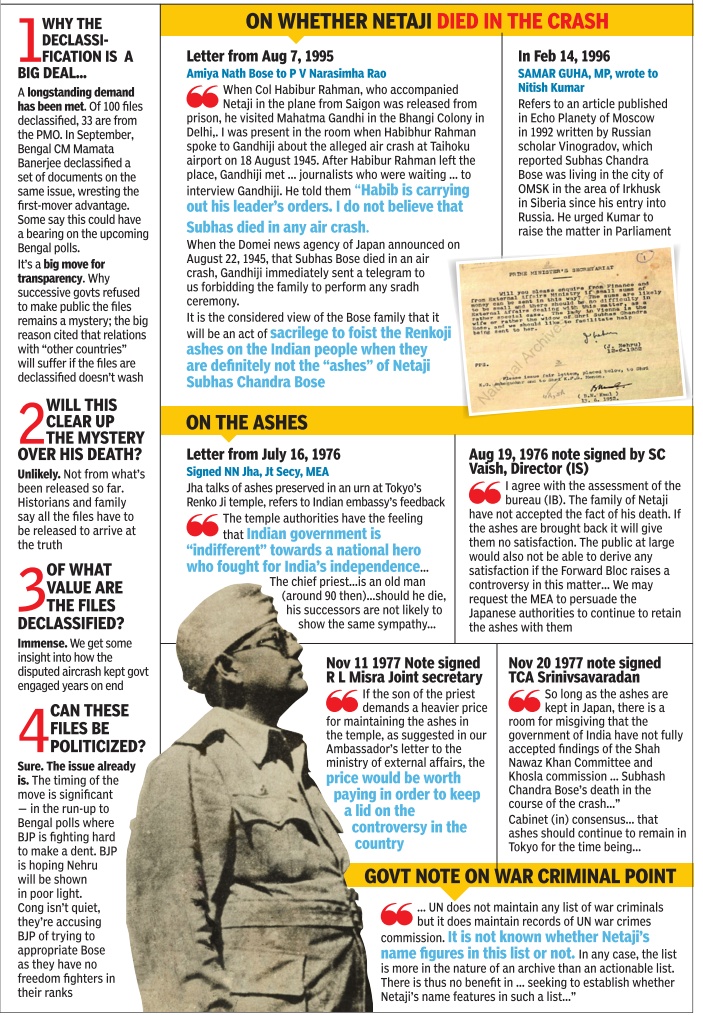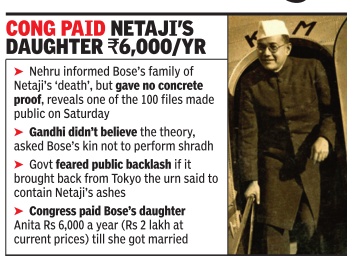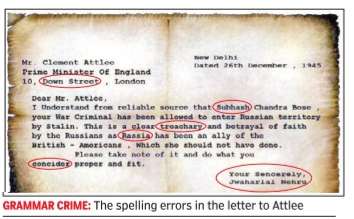Netaji Subhas Chandra Bose: Declassified papers
(Created page with "{| class="wikitable" |- |colspan="0"|<div style="font-size:100%"> This is a collection of articles archived for the excellence of their content.<br/> </div> |} [[Category:Ind...") |
(→Jawaharlal Nehru and Netaji) |
||
| Line 69: | Line 69: | ||
A year later, when Nehru came to the Bose household in Calcutta, he told Netaji's elder brother Sarat Bose that Netaji had died in the air crash. He also presented a watch saying it was recovered from the crash site. Sarat Bose said this was not the watch Netaji wore and rejected the theory of his death. | A year later, when Nehru came to the Bose household in Calcutta, he told Netaji's elder brother Sarat Bose that Netaji had died in the air crash. He also presented a watch saying it was recovered from the crash site. Sarat Bose said this was not the watch Netaji wore and rejected the theory of his death. | ||
| + | |||
| + | =See also= | ||
| + | |||
| + | [[Netaji Subhas Chandra Bose: Biography]] | ||
| + | |||
| + | [[Netaji Subhas Chandra Bose: After-1945]] | ||
| + | |||
| + | [[Netaji Subhas Chandra Bose: Ideology]] | ||
Revision as of 20:06, 25 January 2016
This is a collection of articles archived for the excellence of their content. |
Contents |
1st tranche of declassified files
The Times of India, January 24, 2016


’Death’ reports
Cabinet note on Netaji’s reported ‘death’
The Times of India, Jan 24 2016
Akshaya Mukul & Mohua Chatterjee
No new info, except Cabinet note on death
A hundred secret files relating to Subhas Chandra Bose made public by PM Narendra Modi on the 119th birth anniversary of the freedom fighter on Saturday do not throw new light on much of the existing narrative on Netaji, except for a Cabinet note of February 1995 saying he had indeed died in an air crash in Taipei on August 18, 1945. “There seems to be no scope for doubt that he died in the air crash of August 18, 1945 at Taihoku,“ said the note, adding that the government had accepted that position. In fact, bulk of the secret Netaji files made public on Saturday relate to hundreds of petitions and demands for fresh inquiry into Subhas Chandra Bose's death made by politicians, family members and well-wishers from 1960s till now.
A host of suggestions were made in these representations, including one by journalist Ashish Ray asking Narasimha Rao to get a DNA test conducted of the ashes of Bose kept in Renkoji Temple in Japan. Though bizarre, another suggestion by D N Sinha of All India Qaumi Ekta Committee suggested that bringing Netaji's ashes to India would fetch Congress an extra 1020% votes.
National Archives of India will release into the public domain digital copies of 25 declassified files every month.However, some of the declassified files give an interesting insight into how Jawaharlal Nehru's government treated Bose's legacy .Papers show that since October, 1950, Bose's wife and daughter, based in Vienna, were being financially helped through various government channels, from the Indian mission in Switzerland to Nehru sending a cheque of 100 pounds to her.
A note signed by Nehru (March 14, 1954) shows Rs 2 lakh were set aside for mother and daughter. It was proposed that a trust comprising Nehru, B C Roy and Bo se's wife would be formed and that the money would be sent through non-official source like AICC. Every quarter, Nehru wrote, Rs 1500 -roughly the interest on the corpus -will be sent to the family.
An interesting bit about Bose's death relates to a `treasure box' which some Indians associated with him and which had been given to the head of the Indian mission in Tokyo. The box containing 20,000 yuan (Rs 265 and 10 anna) and gold and jewellery was handed over to the foreign ministry and finally kept in the National Museum.
In 1971, the box was opened and a detailed list was prepared. The file contains the list of each and every item whose total value was more than a lakh rupees. However, the file also mentions that one person who deposed before the Shah Nawaz Khan inquiry committee said the box was tampered with.
Another file talks about letters from Lalita Bose who ran the Netaji Mission in Calcutta, writing to PM Morarji Desai to have a statue of Netaji in front of Red Fort, and have a public holiday in schools and colleges across the country on 23 January and also to provide land for the Mission, but the PM refused to oblige any of the three requests, giving his reasons in a polite letter. (File no 3, NSC Bose)
Jawaharlal Nehru and Netaji
`Jawaharlal' calls `Subhash' war criminal at ‘10, Down Street’
The Times of India, January 24, 2016

`Jawaharlal', and not Nehru, called Bose war criminal
The political war over the legacy of Netaji Subhas Chandra Bose heated up, with Congress accusing the government of deliberately creating a controversy over a purported letter by Jawaharlal Nehru allegedly calling Bose a “war criminal“ and BJP hitting back, saying the main opposition party should apologise for the disrespect it had shown to the legacy and memory of the freedom struggle icon. Congress spokesperson Anand Sharma angrily called the letter “fake and mi schievous“ and aimed at maligning the party . The so-called letter has been doing the rounds of social media and websites without any substantiation and the 100 secret Netaji files declassified on Saturday by PM Narendra Modi have no reference to it.
But the emotive issue was enough to spark off another round of accusations with Sharma saying, “It's a deliberately created controversy to mislead people and a bid to belittle the great achievements of stalwarts of the Indian freedom struggle.“
But BJP said it was an example of Congress tarring the image of leaders with a different viewpoint. One of the disclosures in the Netaji files, made public on his 119th birthday on Saturday , is that Nehru had written to then British PM Clement Attlee about Subhas Chandra Bose, saying, “Your war criminal has been allowed to enter Russian territory by Stalin. This is a clear treachery and betrayal of faith by the Russians, as they were allies of the British and the Americans. Please take care and do what you consider proper and fit.“
While this would appear to confirm a testimony by a stenographer, Shyam Lal Jain, who had told the Khosla Commission set up in 1970 to investigate Netaji's death that he had typed such a letter dictated by Nehru in December 1945, the Congress jumped at the typographical and factual errors to claim it was a hoax.
In the type-written letter, Jawaharlal is spelled `Jwaharlal', the office address of the British PM (described as prime minister of England) given as 10, Down Street, and Subhas spelled as `Subhash'.
A facsimile of the letter soon began circulating online and went viral following which Congress described it as a mischievous act to defame Nehru. “We have said from the very beginning that this is a deliberate controversy ,“ Congress spokesman Anand Sharma said in Delhi.
Besides the several egregious errors, the letter does not bear the watermark of National Archives of India. All other documents declassified on Saturday carry this watermark. It bears Nehru's name as sender but doesn't have his signature. And Russia is misspelled as `Rassia', and yours sincerely as `your sencerely'.
Jain has said he was a ste nographer to Congressman Asaf Ali and the dictation was taken at Ali's residence. Jain also said Nehru, in another letter, had stated that Bose had landed in Diren in Manchuria, and had a meal of banana and tea. Thereafter, he disappeared in a jeep along with Japanese General Shedai and a loaded trunk.
For reasons unknown, the Khosla commission did not take note of Jain's testimony , which asserted that Nehru did not believe Netaji had died in the Taihoku air crash, but thought he had escaped to Russia.
A year later, when Nehru came to the Bose household in Calcutta, he told Netaji's elder brother Sarat Bose that Netaji had died in the air crash. He also presented a watch saying it was recovered from the crash site. Sarat Bose said this was not the watch Netaji wore and rejected the theory of his death.
See also
Netaji Subhas Chandra Bose: Biography